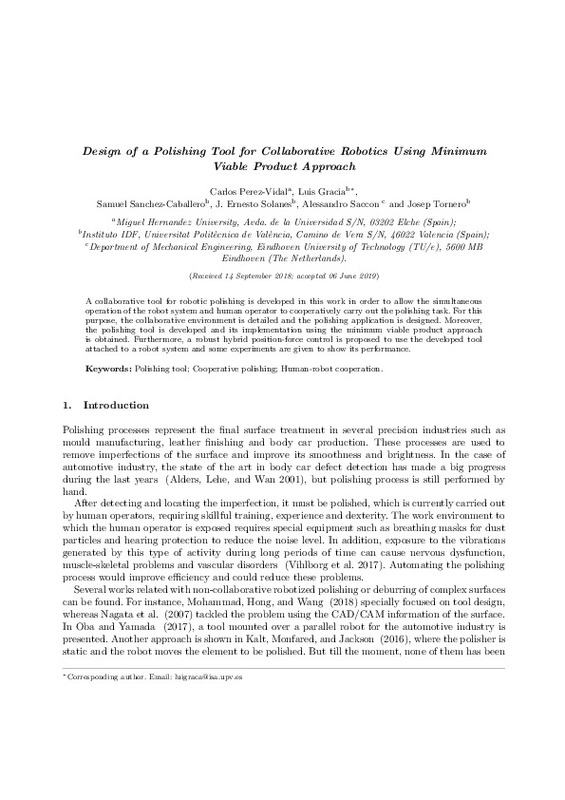Alders, K., M. Lehe, and G. Wan. 2001. “Method for the Automatic Recognition of Surface Defects in Body Shells and Device for Carrying Out Said Method” US Patent 6,320,654, Accessed 2001 November. https://www.google.ch/patents/US6320654
Alexopoulos, K., Mavrikios, D., & Chryssolouris, G. (2013). ErgoToolkit: an ergonomic analysis tool in a virtual manufacturing environment. International Journal of Computer Integrated Manufacturing, 26(5), 440-452. doi:10.1080/0951192x.2012.731610
Andres, J., Gracia, L., & Tornero, J. (2011). Calibration and control of a redundant robotic workcell for milling tasks. International Journal of Computer Integrated Manufacturing, 24(6), 561-573. doi:10.1080/0951192x.2011.566284
[+]
Alders, K., M. Lehe, and G. Wan. 2001. “Method for the Automatic Recognition of Surface Defects in Body Shells and Device for Carrying Out Said Method” US Patent 6,320,654, Accessed 2001 November. https://www.google.ch/patents/US6320654
Alexopoulos, K., Mavrikios, D., & Chryssolouris, G. (2013). ErgoToolkit: an ergonomic analysis tool in a virtual manufacturing environment. International Journal of Computer Integrated Manufacturing, 26(5), 440-452. doi:10.1080/0951192x.2012.731610
Andres, J., Gracia, L., & Tornero, J. (2011). Calibration and control of a redundant robotic workcell for milling tasks. International Journal of Computer Integrated Manufacturing, 24(6), 561-573. doi:10.1080/0951192x.2011.566284
Arnal, L., Solanes, J. E., Molina, J., & Tornero, J. (2017). Detecting dings and dents on specular car body surfaces based on optical flow. Journal of Manufacturing Systems, 45, 306-321. doi:10.1016/j.jmsy.2017.07.006
Blank, S. 2010. “Perfection By Subtraction - The Minimum Feature Set”. Accessed 2018 August. http://steveblank.com/2010/03/04/perfection-by-subtraction-the-minimum-feature-set/
Dimeas, F., & Aspragathos, N. (2016). Online Stability in Human-Robot Cooperation with Admittance Control. IEEE Transactions on Haptics, 9(2), 267-278. doi:10.1109/toh.2016.2518670
Fitzgerald, C. “Developing Baxter, A new industrial robot with common sense for U.S. manufacturing.” 2013.
Gracia, L., Sala, A., & Garelli, F. (2012). A supervisory loop approach to fulfill workspace constraints in redundant robots. Robotics and Autonomous Systems, 60(1), 1-15. doi:10.1016/j.robot.2011.07.008
Gracia, L., Sala, A., & Garelli, F. (2014). Robot coordination using task-priority and sliding-mode techniques. Robotics and Computer-Integrated Manufacturing, 30(1), 74-89. doi:10.1016/j.rcim.2013.08.003
Gracia, L., Solanes, J. E., Muñoz-Benavent, P., Valls Miro, J., Perez-Vidal, C., & Tornero, J. (2018). Adaptive Sliding Mode Control for Robotic Surface Treatment Using Force Feedback. Mechatronics, 52, 102-118. doi:10.1016/j.mechatronics.2018.04.008
Julius, R., Schürenberg, M., Schumacher, F., & Fay, A. (2017). Transformation of GRAFCET to PLC code including hierarchical structures. Control Engineering Practice, 64, 173-194. doi:10.1016/j.conengprac.2017.03.012
. E. K. (2016). TOWARDS AN AUTOMATED POLISHING SYSTEM - CAPTURING MANUAL POLISHING OPERATIONS. International Journal of Research in Engineering and Technology, 05(07), 182-192. doi:10.15623/ijret.2016.0507030
Khan, A. M., Yun, D., Zuhaib, K. M., Iqbal, J., Yan, R.-J., Khan, F., & Han, C. (2017). Estimation of Desired Motion Intention and compliance control for upper limb assist exoskeleton. International Journal of Control, Automation and Systems, 15(2), 802-814. doi:10.1007/s12555-015-0151-7
Kirschner, D., Velik, R., Yahyanejad, S., Brandstötter, M., & Hofbaur, M. (2016). YuMi, Come and Play with Me! A Collaborative Robot for Piecing Together a Tangram Puzzle. Interactive Collaborative Robotics, 243-251. doi:10.1007/978-3-319-43955-6_29
Mohammad, A. E. K., Hong, J., & Wang, D. (2018). Design of a force-controlled end-effector with low-inertia effect for robotic polishing using macro-mini robot approach. Robotics and Computer-Integrated Manufacturing, 49, 54-65. doi:10.1016/j.rcim.2017.05.011
Nagata, F., Hase, T., Haga, Z., Omoto, M., & Watanabe, K. (2007). CAD/CAM-based position/force controller for a mold polishing robot. Mechatronics, 17(4-5), 207-216. doi:10.1016/j.mechatronics.2007.01.003
Nakamura, Y., Hanafusa, H., & Yoshikawa, T. (1987). Task-Priority Based Redundancy Control of Robot Manipulators. The International Journal of Robotics Research, 6(2), 3-15. doi:10.1177/027836498700600201
Ries, E. 2009. “What is the Minimum Viable Product”. March. Accessed 2018 August. http://venturehacks.com/articles/minimum-viable-product
Robinson, F. 2001 “A Proven Methodology to Maximize Return on Risk”. Accessed 2018 August. http://www.syncdev.com/minimum-viable-product
Shepherd, S., & Buchstab, A. (2014). KUKA Robots On-Site. Robotic Fabrication in Architecture, Art and Design 2014, 373-380. doi:10.1007/978-3-319-04663-1_26
SYMPLEXITY. “Symbiotic Human-Robot Solutions for Complex Surface Finishing Operations.” European project funded by E.U. through the H2020. Project no. 637080. Call: H2020-FoF-2014. Topic: FoF-06-2014. Starting date: 01/ 01/2015.Duration: 48 months. Accessed 2019 March. https://www.symplexity.eu/
Vihlborg, P., I. Bryngelsson, B. Lindgren, L. G. Gunnarsson, and P. Graff. 2017. “Associatio between vibration exposure and hand-arm vibration symptoms in a Swedish mechanical industry.” February 2017.
Vogel, J., Haddadin, S., Jarosiewicz, B., Simeral, J. D., Bacher, D., Hochberg, L. R., … van der Smagt, P. (2015). An assistive decision-and-control architecture for force-sensitive hand–arm systems driven by human–machine interfaces. The International Journal of Robotics Research, 34(6), 763-780. doi:10.1177/0278364914561535
[-]







![[Cerrado]](/themes/UPV/images/candado.png)


